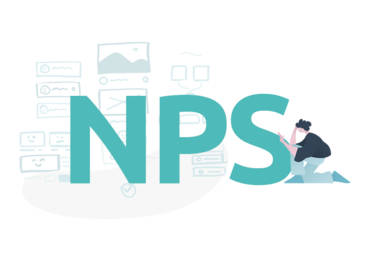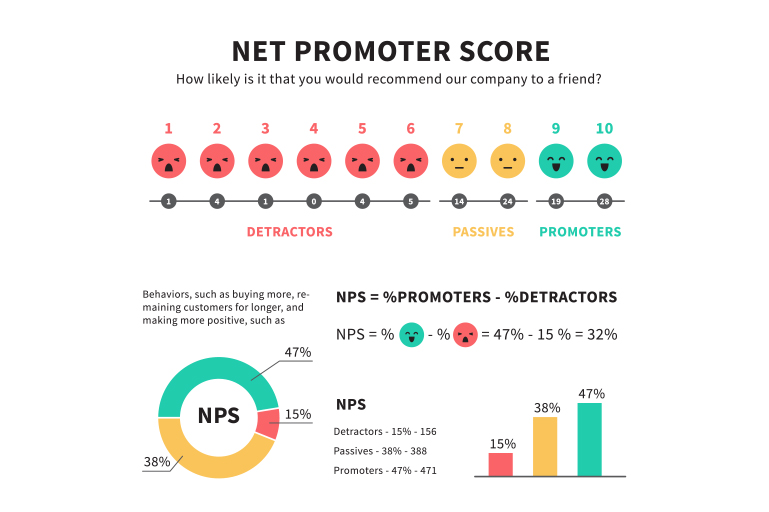What Is Net Promoter Score?

A business thrives only when its customers are loyal. The question is, however, how one can evaluate and then improve this customer loyalty if required. And how to understand which activities have a positive or negative impact on customer loyalty data. Net promoter score is the answer to all of the above-mentioned questions and even more.
What Is the NPS?
In simple words, net promoter score is a customer loyalty metric that was developed back in 2003 Fred Reichheld, Bain & Company. This metrics basically demonstrate what your customers think of your brand in general or a product in particular and can also define your business’s position in the market in relation to the competition. By knowing your company’s net promoter score, you can understand how customers see your performance and then compare it with your own vision of the business.
How to Calculate and Understand Net Promoter Score?
Net promoter score is evaluated with the answers customers give to a single question: How likely is it that you would recommend our service/product/company/brand to a friend or colleague? And then instead of giving customers a possibility to answer freely, they are given a scale from 0 to 10 where 0 means “not likely at all” and 10 means “extremely likely.” The number a test customer selects allows to divide them into three categories: Promoters, Passives, or Detractors.
- 9-10 points – Promoters: these are loyal customers, enthusiasts of your services or products who will continue using your offers and will also refer others, fueling business growth.
- 7-8 points – Passives: these customers are satisfied with whatever you are offering but they are not enthusiastic and hence are vulnerable to the competition’s offers.
- 0-6 points – Detractors: such customers are unhappy with your business and hence can damage your brand and hinder business development with negative word-of-mouth.
The net promoter score equals the difference between your Promoters and Detractors (NPS = Promoters – Detractors).
The rule of the thumb is to have any positive NPS; over 30 points — you are good, over 50 — you are great, over 70 — you are ahead of the competition. However note, that every industry is unique and so there is no unified number of points that can universally state which score is good or great.

What to Do with the NPS Numbers?
Without any doubt, the ultimate goal for any business is to turn all customers into Promoters and eliminate Detractors. Yes, there is an essential point to remember – net promoter score is just a snapshot of your customers' loyalty, it is not a comprehensive measure and should not be treated as one. Of course, if your score is negative, then it is time to rush into proactive steps. Here are the essential fronts that can help you start the improvement process:
- Research further. If your customers are not satisfied with your service, then you are doing something wrong. Dig deeper into the feedbacks and prioritize what should be fixed first. In case you don’t know where to begin, you can always hire customer support experts who will help you build the right support and also analyze the business’ weak spots.
- Motivate inside. Do not hide your net promoter score from the team members. Let everyone know that something is not right and encourage the team to work together. Keep in mind that the team can also have great ideas for improvement, so do not hesitate!
- Focus on the good. After the initial testing within the NPS framework, you will identify your strength. Once acknowledged, work towards keeping up with the good work and expanding its positive influence on the new customers.
How to Improve Your Net Promoter Score?
Always remember that low and even negative NPS score is not the end of the world; this is rather a sign that you need to change your strategy. Collect more information, feedback, and complaints and get down to improving your business model.
First and foremost, identify the most common problems that the question uncovers. Read carefully through all answers and group the issues. Second, prioritize the most common problems, and fix them right away. Third, continue working on improvements while still collecting users’ feedback on your service. Do not hesitate to contact your unsatisfied customers to improve their opinion about your service. This will help you gather more information, and at the same time demonstrate that you are working on improving your service.
Now let’s review what to do after collecting NPS data.

1. Polish Interactions With Customers
NPS allows you to hear the voice of your customers, understand their concerns, and feel their dissatisfaction first-hand. By collecting this data on time and ahead of time, you can prepare for the new demand and adapt your business accordingly. NPS demonstrates the percentage of Promoters you have, hence the effect the old-fashioned word-of-mouth will have. For instance, you might have heard that Slack gained a $1 billion valuation in a year by following the word-of-mouth marketing tracked by NPS. Track what people say about your business, and stay ahead.
2. NPS is a Product Development Tool
No, NPS itself is not a development tool but it can become one if analyzed properly. When customers are not satisfied, your goal is to understand where the dissatisfaction lies. So, create a Voice of Customer team that will be dealing with feedbacks only and will keep the track of NPS. Then these workers will report about the most common problems customers are facing, discuss the possibilities of improving this point with the company's developers and designers, and in the end, the changes will be made based on the market demand. And now imagine that whatever a customer wants from your business, you deliver. This is a perfect world for any customer and any business, so he or she will definitely come back to you over and over again. Follow the feedback and earn money.
3. React on Time
Many businesses neglect the necessity of reviewing customers’ feedback and put aside the NPS completely. As a result, when they get to read what the market thinks of them, it already does not matter — the clients are lost forever.
NPS data is valuable when tracked in real time and reacted to in real time. For example, if someone says that there is no possibility to select NY as the state for a product delivery on an e-commerce platform operating on the East coast, and the business owner reacts to this problem half a year later, then over these six months he loses the biggest piece of the market’s current and potential customers. And if the problem was addressed sooner, the sales would only expand instead of shrinking. Remember that it’s a dinner time when the spoon comes in handy, not later.
Net promoter score is the easiest way to evaluate your customers' satisfaction and loyalty to the brand. Use the metrics wisely: collect as much as you can, analyze as fast as possible, and implement changes promptly to keep up the satisfaction level and ensure that you outrun the competitors in delivering the best services in the market.
